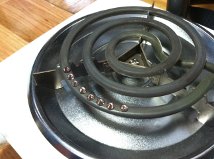How to Heat a Zircon
My friend Anya and I were buying some stones at a gem dealer friend’s house last weekend. When we got there, we saw some rosy colored gems on his desk and I asked what they were. “Zircons”, he said. “I just heated them.”
In general, gentle heat (low heat) is a more acceptable form of treatment than high heat. But it isn’t always permanent. Again it depends on the stone. When sapphires are heated, the treatment is permanent. But I’ve seen lemon quartz turn white over time.
There are also stones that don’t do anything when you heat them. The garnet family and for now, spinels belong into that family. I’m very proud of those stones. J
But let’s get back to “our” zircons. My gem dealer friend J. (who also sells me the Mahenge spinels, by the way), placed a set of dark brown stones straight onto the burner of his little camping cooker. Then he turned the heat on low and we sat there and waited. After a couple of minutes, maybe 3 or 4, no more, the stones started to brighten up. You could literally see them change color over the next 2-3 minutes. They turned into a nice rosy pink, and some into more of a champagne color. J. explained that the effects are not all equal, some stones transform into champagne, some more into pink. And if you leave them on long enough, they turn white. But we took the stones off the burner before that. First, J. turned the burner off, then he placed the stones one by one on a tray to cool them, using his tweezers. They have to cool down slowly and naturally, otherwise they can crack.
You can see the results in our pix. Pretty neat, isn’t it?
“Huh?” I didn’t know heating could be this low tech. Because we were standing in his home office, and he didn’t have any particular equipment that suggested whatever fancy heating process I was imagining. So he demonstrated. Anya took the pix.
But first, a little background: many gems on the market today are heated. Heating can do a number of things.
1. Change the color: amethyst can be heated to “turn into” citrine.
2. Brighten or lighten the color: brown zircons can be turned white.
3. Deepen the color: light colored Ceylon sapphires can be made cornflower blue.
4. Melt inclusions: rubies can look cleaner, though not crisper (heating lessens the brilliance).
Gems react to temperatures in various ways. An aqua can be subjected to low heat to drive away the greens, but when subjected to high heat, it cracks. Many aquas suffer that fate during the heating process when it isn’t done with care. Sapphires can be subjected to low and high heat. But for high heat, they have to be packed in borax, which can seep into the stone and leave trace bubbles (and that’s also how you know a sapphire has been subjected to high heat). A sapphire subjected to high heat can sometimes be called “glass filled” but that’s not the same as “lead glass filled”. The latter is done to rubies and is not considered an acceptable form of treatment. It devalues a gem considerably more than any other form of treatment and should always be disclosed.In general, gentle heat (low heat) is a more acceptable form of treatment than high heat. But it isn’t always permanent. Again it depends on the stone. When sapphires are heated, the treatment is permanent. But I’ve seen lemon quartz turn white over time.
There are also stones that don’t do anything when you heat them. The garnet family and for now, spinels belong into that family. I’m very proud of those stones. J
But let’s get back to “our” zircons. My gem dealer friend J. (who also sells me the Mahenge spinels, by the way), placed a set of dark brown stones straight onto the burner of his little camping cooker. Then he turned the heat on low and we sat there and waited. After a couple of minutes, maybe 3 or 4, no more, the stones started to brighten up. You could literally see them change color over the next 2-3 minutes. They turned into a nice rosy pink, and some into more of a champagne color. J. explained that the effects are not all equal, some stones transform into champagne, some more into pink. And if you leave them on long enough, they turn white. But we took the stones off the burner before that. First, J. turned the burner off, then he placed the stones one by one on a tray to cool them, using his tweezers. They have to cool down slowly and naturally, otherwise they can crack.
You can see the results in our pix. Pretty neat, isn’t it?
 |
| Zircons before Heating |
 |
| Zircons After a Few Minutes |
| Zircons after Heating |
